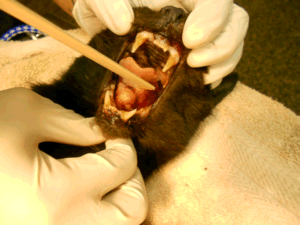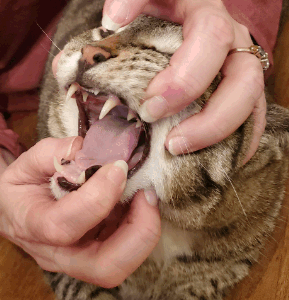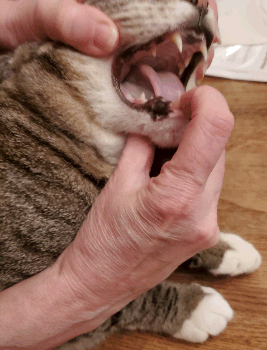Tongue squanoma

Image Courtesy of MarVistaVet
Squamous cell carcinoma is not only the most common oral malignancy in cats, it has one of the poorest outcomes. In most cases, the goal is to minimize infection and pain until the tumor has advanced to a state where comfortable eating and/or breathing is not possible. The tumor is treatable only if detected early in its course.
Prevention and Risk Factors
While sun exposure is an important risk factor for squamous cell carcinoma on the ears and nose, the owner's cigarette smoking habits turn out to be one of the most important risk factors for oral squamous cell carcinoma. The risk goes up four times when the owner smokes 1 to 19 cigarettes daily. Cats who have at one time lived with a smoker have an increased risk over cats that have always lived in non-smoking homes.
The use of flea collars was associated with a five-fold increase in the development of oral squamous cell carcinoma, although the study that found this correlation was not able to differentiate between different types of flea collars. Interestingly, regular flea shampoo use was associated with a 90% reduction in risk (perhaps a surface toxin is washed away by frequent bathing).
Regular feeding of canned food, especially tuna fish, was associated with increased risk for the development of oral squamous cell carcinoma. In humans, poor oral hygiene has been associated with an increased risk for oral squamous cell carcinoma, so it is speculated to be the basis of the canned food correlation in cats as well.
The average age at diagnosis is 12.5 years. This tumor usually occurs in older cats. Get comfortable looking in your cat's mouth.
Where to Look
Looking inside a cat's mouth

Holding the cat's mouth open like this is the way to start looking at your cat's mouth. Image Courtesy of MarVistaVet
The squamous cell carcinoma often grows from the gums surrounding the teeth or under the tongue. To look under a cat's tongue, press your thumb upward from under the chin (in the soft area between the lower jaw bones). This will raise the base of the tongue upward; when the cat's mouth is open, it's easy to see the root of the tongue. Become familiar with the symmetry and contour of your cat's jaws, both upper and lower.
- Cats requiring multiple adjacent dental extractions (i.e., they need a couple of adjacent teeth with rotten roots to be pulled) often have a tumor in this area. A gum biopsy is a good idea.
- Hard swelling of the cheekbone or lower jawbone can be a sign of a tumor.
- If a cat loses a tooth (particularly a fang) and the hole simply will not heal, this is a sign of a tumor and the area should be biopsied.
- Unexplained odor or even ulceration in the mouth can be a sign of a tumor.
Regular teeth cleaning is important for all pets. In pets, regular dental care at the vet's office may mean early tumor detection.
Testing
Benign lesions can look similar to malignant lesions to the naked eye, and possibly even on radiographs, so a biopsy needed is for the correct diagnosis. In most cases, some kind of sedation and dental evaluation is needed to get close enough to the area in question. If a small sample of tissue can be harvested, the diagnosis should be revealed.
Sometimes suspicious tissues are aspirated with needles to harvest cells for diagnostic purposes. It is particularly helpful to aspirate an enlarged lymph node or swelling to see if there is a tumor. Aspiration is not as accurate as biopsy but is less invasive and may not require anesthesia depending on the location of the suspected tumor. Fine needle aspiration is a test your veterinarian may recommend.
Holding tongue in a cat's mouth

Image Courtesy of MarVistaVet
The squamous cell carcinoma is a destructive tumor. Underlying bone is commonly eaten away. Findings of bone destruction on a radiograph may also be helpful in establishing diagnosis.
Computed tomography (CT or CAT scan) is needed to determine the extent of the tumor. If surgery is considered, knowing the tumor margins is crucial and radiographs simply cannot accurately show how far the tumor extends.
Treatment
Sadly, options are limited for treating oral squamous cell carcinoma; fewer than 10% of cats survive one year from the time of diagnosis. Cats are euthanized when they become too disfigured to eat or breathe. Still, the situation is not without options and some situations are more favorable than others.
Your primary veterinarian or veterinary oncologist will recommend treatment options specifically for your pet’s condition.
Surgery (Mandibulectomy)
When it comes to oral squamous cell carcinoma, the best-case scenario is a tumor in the front of the lower jaw, because this area can be surgically removed.
If the tumor is located on the lower jaw, it may be possible to remove the part of the lower jaw that contains the tumor. This surgery is called mandibulectomy and is preceded by a CT scan (where available) to determine the margins of the tumor.
- Median survival times of five to seven months were obtained with this technique, depending on the study. The goal is to remove 1 cm (approx. 1/2 inch) around the tumor in all directions.
- After mandibulectomy, a cat can be expected to experience at least one of the following problems: drooling, difficulty grooming, poor appetite, and/or trouble swallowing in the first month after surgery. For most cats (76%), at least one of these problems is permanent, although most owners (83%) felt their cats had good life quality anyway and would choose to do the procedure again in similar circumstances.
- If a cat survives to the one-year mark, there is a good chance of survival to the two-year mark as well. (The same survival percentages are found at one year and at two years.)
- The recurrence rate after mandibulectomy is approximately 38%.
If the tumor is located in the upper jaw, surgery is probably not an option (see below).
Mandibulectomy Combined with Radiotherapy
The longest survival times (14 months) have been yielded by a combination of surgery and radiotherapy. The study reporting this rather long survival time only reviewed seven affected cats, a relatively small number upon which to draw generalizations. These cats, however, all required feeding tubes for a median of 15 days and had drooling issues and required regular cleaning (usually daily) on the chest and feet long term.
Radiotherapy with or without Chemotherapy
Radiotherapy can be definitive (intended to cure) or palliative (intended to slow disease and improve life quality but not cure). If surgery can reduce the tumor size to what is called microscopic disease, meaning no tumor is visible to the naked eye, radiation after healing provides the longest survival times. If the tumor is too large to remove to this state, definitive radiation is not going to be possible, but palliative radiation is still an option if it is aggressively done (twice daily treatments for 9-10 days). In this situation, median survivals of 5-6 months were obtained. Similarly, another study showed promising results: a group of 11 cats with oral squamous cell carcinoma treated with a combination of radiation and the chemotherapy agent mitoxantrone yielded complete remission in 8 cats with a median duration of 170 days. It should be noted radiotherapy is generally a very expensive treatment and, when the mouth is involved, can create enough inflammation that a feeding tube is necessary to support the patient.
Chemotherapy alone has shown such poor efficacy that it is not worth the attempt for this tumor.
Non-steroidal anti-inflammatory Drugs (NSAIDs)
It has recently been found that certain tumors, particularly carcinomas, have receptors to bind the enzyme cyclooxygenase (lovingly known as COX). This enzyme is involved in the production of biochemicals called prostaglandins that are involved in the generation of inflammation. Cyclooxygenase inhibitors such as piroxicam and even meloxicam, two drugs more commonly used against arthritis pain, may have anti-cancer properties beyond simply controlling inflammation and pain associated with tumors. Often, these drugs are prescribed for cats with oral squamous cell carcinoma but be aware that cats can be sensitive to their side effects. Often, treatment of the tumor justifies this risk but still, you should be aware of potential complications and discuss the timing of monitoring blood tests with your veterinarian.
The bottom line is that the oral squamous cell carcinoma is a very bad tumor for a cat, and as yet, research has not yielded a reliably good therapy. Because the tumor does not spread until late in its course, removing the tumor when it is small is the best hope for a worthwhile survival time. The lower jaw tumors are best suited to this kind of therapy; other forms, such as tumors under the tongue or in the upper jaw, are nearly impossible to address meaningfully, though aggressive radiotherapy is emerging as an option. It is important to keep a realistic attitude about what to expect.
Information in this article was largely obtained from the following review article: Marretta, J.J., Garrett, L.D., Marretta, S.M. Feline oral squamous cell carcinoma: an overview. Veterinary Medicine, June 2007; p392-406.
Other Types of Oral Squamous Cell Carcinoma
As mentioned, it is difficult to achieve meaningful treatment for a squamous cell carcinoma in the upper jaw and less than 10% of patients are still alive one year after diagnosis. In fact, most cats have stopped eating and require euthanasia within one month or so. Even with palliative radiotherapy only 1 to 4 months of survival are reported. That said, a new therapy is emerging in the form of aggressive radiotherapy. This protocol involves twice daily radiation of the tumor area for 7 days. With this protocol, after therapy 56% of feline patients had no discernible tumor for an average of 13 months. A feeding tube is placed during the time of therapy and kept throughout the recovery time until the cat is eating well and the radiation site is healed. This kind of therapy is relatively expensive but for a 50:50 shot at a long remission it may well be worthwhile.